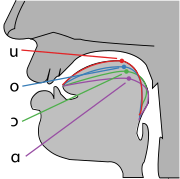Vogalennoù a gentañ renk : diforc'h etre ar stummoù
Neal (kaozeal | degasadennoù) lañs |
(Disheñvelder ebet)
|
Stumm eus an 30 Mez 2007 da 09:25
Un danvez pennad eo ar pennad-mañ ha labour zo d'ober c'hoazh a-raok e beurechuiñ.
Gallout a rit skoazellañ Wikipedia dre glokaat anezhañ.
Er yezhoniezh e vez implijet an termen vogalenn a gentañ renk (saoz.: cardinal vowel) war tachenn ar fonologiezh hag ar fonetik evit komz eus





Cardinal vowels are a set of reference vowels used by phoneticians in describing the sounds of languages. For instance, the vowel of the English word "feet" can be described with reference to cardinal vowel 1, [i], which is the cardinal vowel closest to it.
A cardinal vowel is a vowel sound produced when the tongue is in an extreme position, either front or back, high or low. The current system was systematised by Daniel Jones in the early 20th century, though the idea goes back to earlier phoneticians, notably Ellis and Bell.
Three of the cardinal vowels, [i], [ɑ] and [u] have articulatory definitions. [i] is produced with the tongue as far forward and as high in the mouth as is possible (without producing friction), with spread lips. [u] is produced with the tongue as far back and as high in the mouth as is possible, with pursed lips. This sound can be approximated by adopting the posture to whistle a very low note, or blow out a candle. [ɑ] is produced with the tongue as low and as far back in the mouth as possible.
The other vowels are 'auditorily equidistant' between these three 'corner vowels', at four degrees of aperture or 'height': close (high tongue position), close-mid, open-mid, and open (low tongue position). The Ngwe language of West Africa has been cited as a language with a vowel system that has 8 vowels which are rather similar to the 8 primary cardinal vowels (Ladefoged 1971:67).
These degrees of aperture plus the front-back distinction define 8 reference points on a mixture of articulatory and auditory criteria. These eight vowels are known as the eight 'primary cardinal vowels', and vowels like these are common in the world's languages.
The lip positions can be reversed with the lip position for the corresponding vowel on the opposite side of the front-back dimension, so that e.g. Cardinal 1 can be produced with the rounding for Cardinal 9, etc.; these are known as 'secondary cardinal vowels'. Sounds such as these are less common in the world's languages. Other vowel sounds are also recognised on the vowel chart of the International Phonetic Alphabet.
Table of cardinal vowels
In the IPA's number chart, the cardinal vowels have the same numbers used above, but added to 300.
